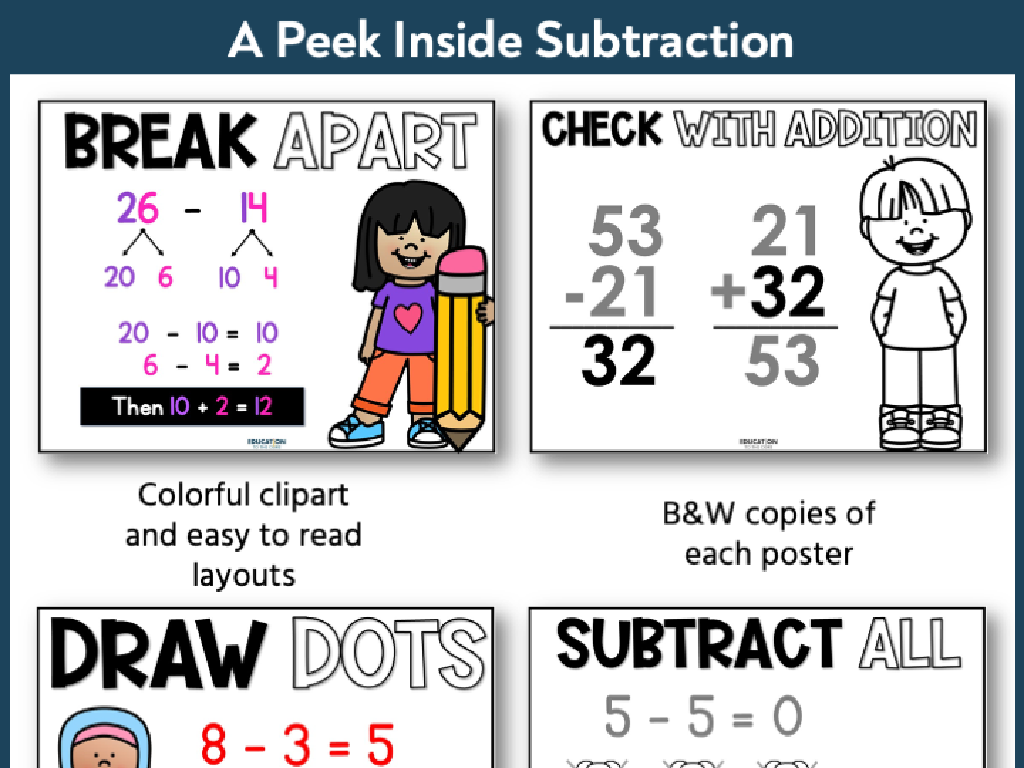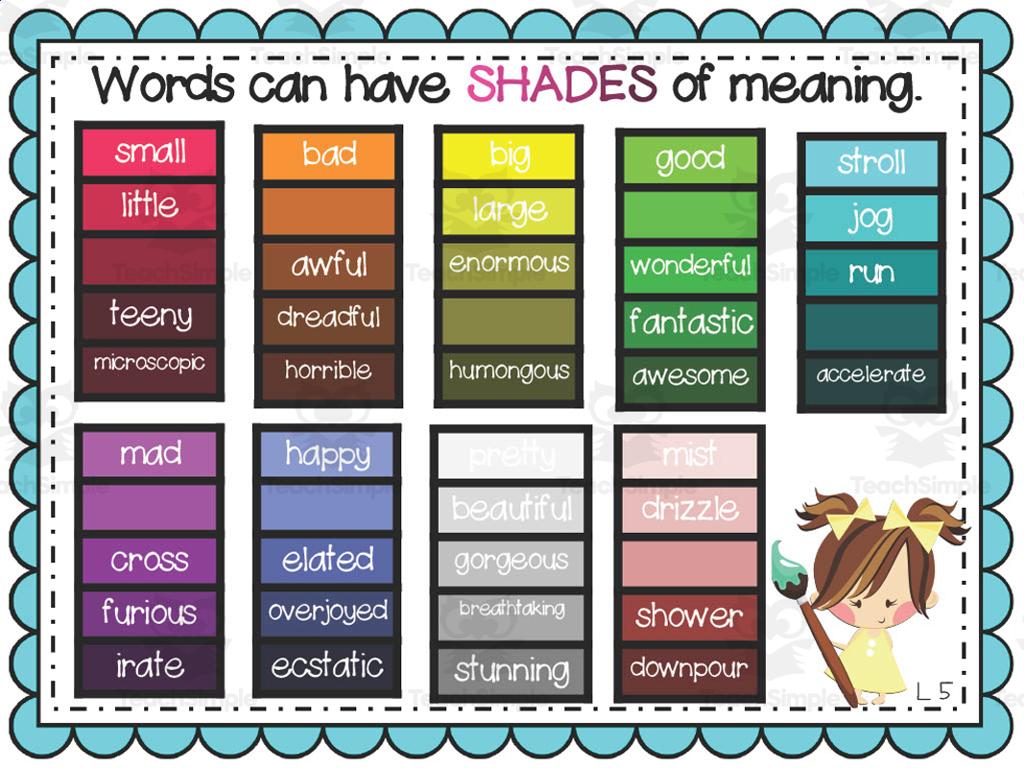Estimate Quotients Using Compatible Numbers: 1-Digit Divisors
Subject: Math
Grade: Fourth grade
Topic: Divide By One-Digit Numbers
Please LOG IN to download the presentation. Access is available to registered users only.
View More Content
Welcome to Division: Estimating Quotients
– Division as equal sharing
– Imagine splitting 12 cookies equally among 4 friends.
– Quotients: Division results
– If 12 cookies are shared by 4 friends, each gets 3 cookies. That’s the quotient.
– Estimating makes division easy
– Instead of exact numbers, use close numbers that are easy to divide.
– Practical uses of estimation
– Like guessing how many candies fit in a jar or sharing slices of pizza.
|
This slide introduces students to the concept of division as a method of sharing equally and explains what quotients are. Emphasize that estimating quotients using compatible numbers simplifies division, making it quicker and easier, especially when exact answers are not necessary. Provide relatable examples to show why estimation is a useful skill in everyday life, such as dividing treats or sharing items among a group. Encourage students to think of other scenarios where they could use estimation. The goal is to make them comfortable with the idea of estimation and to understand its practical applications.
Estimating Quotients with Compatible Numbers
– What are compatible numbers?
– Numbers that are easy to divide mentally, like 30 and 5.
– Examples of compatible numbers
– 300 ÷ 50 is hard, but using 300 ÷ 25 = 12 is easier.
– Simplifying division with compatibility
– Compatible numbers help find close, easy-to-calculate estimates for division problems.
– Practice estimation with examples
– Let’s try 452 ÷ 6 by rounding 452 to 450, which is easier to divide.
|
This slide introduces the concept of compatible numbers, which are numbers that are easy to divide together without a calculator. For example, 30 is compatible with 5 because 30 divided by 5 equals 6, a simple calculation. By providing examples, students can see how using compatible numbers simplifies division. It’s important to demonstrate how to round numbers to find the nearest compatible numbers and use them to estimate quotients. Encourage students to practice with different numbers to become comfortable with estimation. This skill will help them in mental math and when they don’t have access to a calculator.
Estimating Quotients with Compatible Numbers
– Steps to estimate quotients
– Find numbers close to the original that divide evenly
– Value of estimation skills
– Estimation saves time and helps check work
– Estimation in daily life
– Useful in shopping, cooking, and budgeting
– Practice with real examples
|
This slide introduces students to the concept of estimating quotients using compatible numbers, which are numbers that are easy to divide mentally. Start by explaining the steps to find compatible numbers close to the original numbers that can be divided without a remainder. Emphasize the importance of estimation as a skill that can make math quicker and easier, especially when exact answers are not necessary. Provide real-life examples where estimation is beneficial, such as figuring out if you have enough money to buy something or adjusting a recipe. Encourage students to think of other situations where they could use estimation. Conclude with practice problems that involve real-life scenarios to reinforce the concept.
Let’s Practice Estimating Quotients!
– Estimate with round numbers
– Round to nearest ten or hundred to simplify division
– Estimate with close numbers
– Use numbers near each other for easier mental math
– Group activity time
– Work together to estimate quotients of given problems
– Understand estimation benefits
|
This slide is designed to engage fourth-grade students in practicing estimation with quotients using 1-digit divisors. Start by demonstrating how to round numbers to the nearest ten or hundred to make division simpler, which is especially helpful when dealing with large numbers. Then, show how to use numbers that are close to each other to estimate more efficiently, which can be quicker than rounding in some cases. For the group activity, divide the class into small groups and provide a set of division problems for them to estimate the quotients. Encourage collaboration and discussion among group members. Emphasize that estimation is a valuable skill for making quick and reasonable calculations without needing an exact answer. Provide detailed guidelines for the teacher on how to facilitate the activity, including suggestions for division problems to use, tips for grouping students, and ways to encourage discussion and participation.
Estimation in Action: Solving Everyday Problems
– Learn to estimate in division
– Use rounding to guess quotients with 1-digit divisors
– Estimation’s role in daily life
– Helps in quick calculations, like shopping or cooking
– Share your estimation stories
– Discuss times you’ve estimated at home or in school
– Understand estimation’s value
|
This slide aims to make students appreciate the practicality of estimation in division. Begin by explaining how estimation works with simple examples, such as rounding numbers to the nearest ten to quickly find a quotient when dividing by a 1-digit number. Emphasize how estimation is a useful skill in everyday life, aiding in making quick decisions without needing exact numbers, such as when shopping on a budget or measuring ingredients while cooking. Encourage a class discussion where students share their own experiences with estimation, fostering an interactive learning environment. Highlight that estimation is not about finding the perfect answer, but rather a close enough figure that helps us in various situations.
Class Activity: Estimate the Groceries!
– Work in groups for estimation
– Use compatible numbers for items
– Round prices to nearest whole number for easier calculation
– Compare estimates with real prices
– How close were the estimates to actual costs?
– Discuss findings with the class
– Share different strategies used for estimation
|
This interactive group activity is designed to help students understand the concept of estimation using compatible numbers with 1-digit divisors. Divide the class into small groups and provide each with a grocery list including prices. Students will round the prices to the nearest whole number and estimate the total cost. Afterward, they will compare their estimates to the actual prices to see how close they were. Facilitate a discussion on the different strategies used by each group for estimation. This will help students grasp the practical application of estimation in everyday situations like shopping. Possible variations of the activity could include estimating the cost of items on sale, buying in bulk, or applying a discount.
Review and Reflect: Estimating Quotients
– Estimation techniques learned
– Reviewed rounding numbers & finding close multiples
– Importance of estimation
– Estimation saves time & helps check work
– Share your interesting finds
– Discuss any aha moments or surprises
– Reflect on estimation skills
|
This slide aims to consolidate the students’ understanding of estimating quotients using compatible numbers with 1-digit divisors. It’s crucial to emphasize the value of estimation in making math quicker and verifying the accuracy of answers. Encourage students to think about and share what they found intriguing or challenging during the lesson. This reflection helps them to recognize their progress and solidify their learning. As a teacher, be prepared to guide the discussion, highlighting key points and praising students for their efforts and insights. Offer examples such as estimating costs while shopping or dividing items among friends to illustrate the practical use of estimation in everyday life.
Homework Challenge: Estimation in Action!
– Find 5 home situations for estimation
– Record your estimated results
– Think about chores or activities
– Compare with actual results
– Were your guesses close to reality?
– Share your discoveries next class
|
This homework assignment is designed to help students apply the concept of estimation with compatible numbers to real-life situations. Encourage them to think about daily activities such as cooking, shopping, or organizing, where estimation could be useful. They should write down their estimations, then measure or count to find the actual results, and compare the two. This will help them understand the practicality and relevance of estimation in everyday life. In the next class, students will have the opportunity to discuss their findings, which will reinforce their learning and allow them to learn from each other’s experiences.






